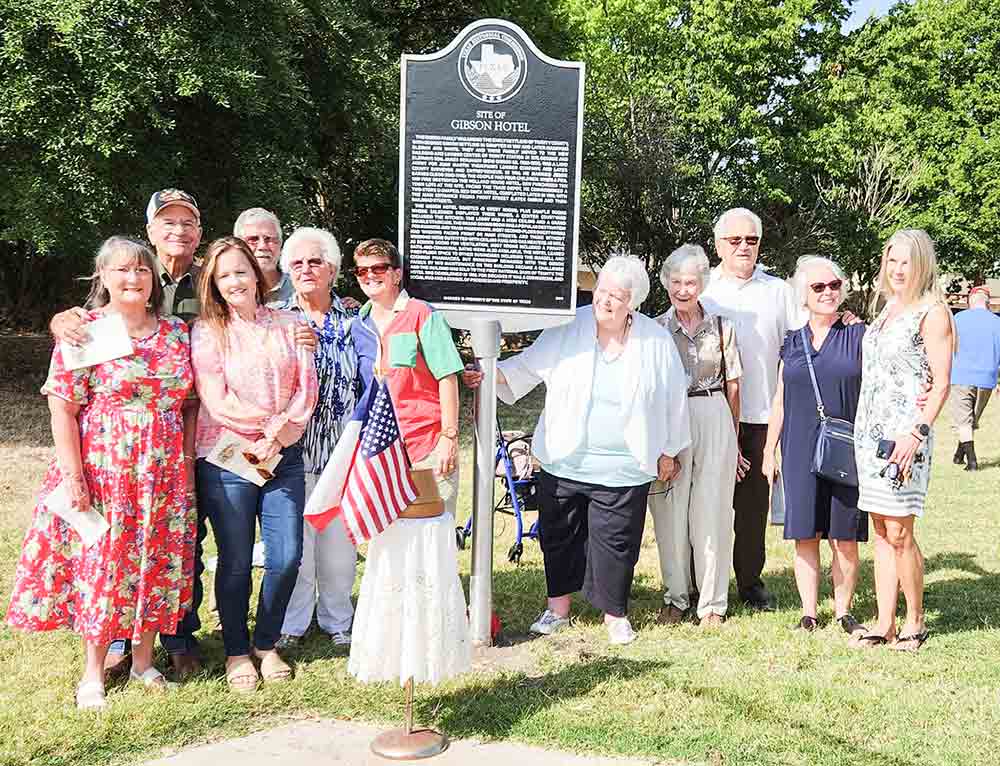Gibson Hotel receives official Texas Historical Marker
 Family members and other Trinity residents commemorate the installation of a historical marker at the site of the Gibson Hotel. courtesy photo
Family members and other Trinity residents commemorate the installation of a historical marker at the site of the Gibson Hotel. courtesy photo
Special to the News-Standard
TRINITY — On July 26, The Trinity Historical Society and the Trinity County Historical Commission hosted the Official Historical Marker Dedication for the Gibson Hotel Site, located at the corner of Main and Railroad Streets in Trinity.
Grandchildren and descendants of J.B. Gibson, as well as guests, were in attendance for the celebration.
Smokey Culver, a local poet, presented the group with a “Farewell to the Gibson Hotel” poem to commemorate the occasion. There will be a display of Gibson Hotel photos and articles featured at the Blanche K. Werner Public Library.
The marker reads:
SITE OF GIBSON HOTEL
The Gibson Family was among the early settlers of Trinity County, with George Gibson settling in sumpter in 1857 and later marrying Elzirah Ann White. They and their family moved to the new railroad and lumber center of Trinity Station in 1872. George and Elzirah’s son, James Benjamin (Ben) Gibson Sr. (1863-1937), was a land agent for John Martin Thompson’s lumber company, and later county surveryor and entrepreneur. In 1906, he married jessie barns clegg (1883-1948); the couple had four children. When a February 1909 fire destroyed Holland House Hotel, Ben purchased 10 town lots at the site, facing the train depot. He commissioned a two-story, u-shaped, red brick hotel, completed later in 1909, with the main entrance facing front street (later Gibson and then Railroad Street).
The Gibson Hotel boasted 40 guest rooms, plus sample rooms where salesmen displayed their wares. A center courtyard included the kitchen. The lobby had a high ceiling and a grand double staircase. The grand dining room was a popular destination for business and train passengers. Most second-floor guest rooms had windows facing front or main streets, and those without windows were outfitted with ceiling fans and gas heaters as well as screen doors for ventilation. Most rooms included a private bath, and communal baths were also available. The hotel leased first-floor space to other businesses including Mansel and Cochran pharmacies, but ownership remained with the Gibson Family. By 1970 maintenance on the building became a challenge and the building was sold to the First National Bank of Trinity. The hotel was demolished in 1980. For decades it was a commercial and social hub and a symbol of progress and prosperity.
Related Articles
“The Official Texas Historical Marker program helps bring attention to community treasures and the importance of their preservation,” said Mark Wolfe, executive director of the THC. “Awareness and education are among the best ways to guarantee the preservation of our state’s history. This designation is a tool that will increase public awareness of important cultural resources.”
A subject qualifies for a marker if two basic criteria are met: historical significance and age. Historical significance is established by reviewing its role and importance in local history and the age requirement depends on the topic.
The THC’s Official Texas Marker Policies are outlined in the “Official Texas Historical Marker Procedures,” which may be obtained by contacting the History Programs Division, Texas Historical Commission, at (512) 463-5853 or visiting the web site at www.thc.texas.gov.
There are three types of Texas Historical Markers. Subject markers are posted solely for public education awareness and awarded more frequently than the Recorded Texas Historic Landmark, which is a legal designation for historic structures and comes with a measure of protection.
Unlike subject markers, the RTHL must also meet a third criterion — architectural integrity. Historic Texas Cemetery markers identify cemeteries which have obtained the HTC designation and whose histories have been researched in detail.
Texas has the largest marker program in the United States with approximately 15,000 markers. Seventeen states have used the Texas program as a model; the THC reviews more than 300 marker applications each year.
“It is vital that as we move forward, we do not forget our past,” said Susanne Waller, Chair, Trinity County Historical Commission. “Not only will the Texas Historical Marker provide awareness in the community of our fascinating history, but it will become a building block for the promotion of local tourism.”
Waller also said she has recently received notice from the state that two historical markers applications sent in this year have been approved. The Trinity Volunteer Fire Department and the Baldwin Chapel Baptist Church in Groveton have been approved by the Texas Historical Commission and are now moving through the process.
For questions regarding the marker programs contact Waller at (936) 642-0242 or email This email address is being protected from spambots. You need JavaScript enabled to view it.. The office for the Trinity County Historical Commission is located at the Trinity County Museum, 490 W. First St., in Groveton.
The Texas Historical Commission is the state agency for historic preservation. The agency administers a variety of programs to preserve the archeological, historical and cultural resources of Texas.
You are a guest
or post as a guest
Be the first to comment.

